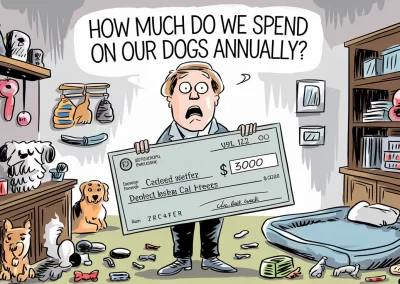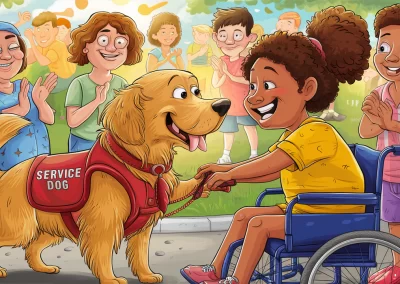The Rainbow Bridge. . Losing a pet can be just as heartbreaking as losing a close friend or family member. Pets are often considered family members, providing unconditional love, companionship, and joy.
Pet bereavement leave could help employees cope with this significant loss, ensuring they return to work feeling supported and more productive.

Many pet owners form deep emotional bonds with their pets. When these relationships end, the grief can be intense.
Imagine trying to focus at work while grieving the loss of a beloved pet. Companies that acknowledge this pain and offer time off are showing they care about their employees’ mental health. This policy could lead to higher employee satisfaction and loyalty.
Some companies, like Mars PetCare, already understand the importance of pet bereavement leave. They offer flexible hours or a few days off when a pet dies.
Such policies are rare but could become more common as awareness grows about the profound impact pets have on our lives and mental well-being.
Understanding Grief Over Pet Loss
Losing a pet can be as heartbreaking as losing a human family member. The deep bond between pet owners and their pets can make this grief intense and difficult to cope with.
The Bond Between Pet Owners and Their Pets
Pets are much more than animals; they are companions, family members, and often, a pet owner’s best friend.
Whether it’s the wagging tail of a dog greeting its owner at the door or the purring of a cat curled up in a lap, these everyday moments form a deep emotional connection.
Pets provide unconditional love and constant companionship. They listen without judgment, offer comfort during tough times, and celebrate good times.
This strong bond makes their loss incredibly painful. For many pet lovers, the connection with their pet is unique and irreplaceable, which intensifies the mourning process when they pass away.
The Impact of Pet Death on Emotional Well-being
Pet loss can trigger profound emotional responses. Many pet owners experience grief similar to losing a human loved one. This includes feelings of sadness, emptiness, and sometimes even depression.
This emotional impact can affect daily life, including work and social relationships.
Grieving the loss of a pet is not only about missing their physical presence. It includes adjusting to the absence of their companionship and routine.
This can lead to various emotional and physical symptoms, such as crying, changes in appetite, and trouble sleeping. Understanding that these reactions are normal can help pet owners navigate their grief and seek support when needed.
Grief over pet loss is significant and should be recognized and respected. Pet owners need time and support to process their loss and begin healing. Recognizing the deep bond and emotional impact can help create a compassionate environment for those grieving their beloved pets.
Benefits of Pet Bereavement Leave
When companies offer pet bereavement leave, they provide much-needed emotional support and help maintain workplace morale. These benefits are crucial for both employees and employers.
Emotional Support for the Bereaved
Losing a pet can be deeply painful. By offering pet bereavement leave, companies acknowledge the emotional impact and provide time for employees to grieve the loss. This helps them process their feelings without the added stress of work.
Granting time off shows that a company cares about its workers’ emotional well-being. This fosters loyalty and appreciation among employees. Such support can make a difference in their overall mental health, allowing them to return to work more focused and less emotionally burdened.
When employees feel understood and supported by their employer, it creates a positive work environment. They are more likely to share their experiences, creating a more compassionate workplace.
Maintaining Workplace Morale
An employee grieving the loss of a pet might struggle with productivity. Pet bereavement leave allows them to take necessary time off, preventing potential declines in workplace performance. This is crucial for maintaining consistent productivity levels across the team.
Coworkers may also feel the emotional impact when a colleague is visibly distressed. By granting leave, companies help reduce workplace tension and promote a healthier atmosphere. This can lead to better overall workplace morale and harmony.
Offering this benefit can also improve the company’s reputation, attracting potential employees who value such compassionate policies. Companies like Kimpton Hotels already offer such leave, setting an example for others.
How Time Off Aids the Healing Process

Taking time off when a pet dies can be crucial. It provides the necessary room to process grief and allows space for healing practices.
The Role of Time in Grieving
Time off from work can be a lifeline during bereavement. It helps manage the immediate shock and emotional pain.
When a pet dies, the distress can be overwhelming. Bereavement leave gives people the chance to step back from daily responsibilities.
Imagine trying to work while mourning a pet. It’s tough to focus and productivity can drop. Taking time off allows employees to grieve without the pressure of work. This, in turn, helps them return refreshed and more focused. Counseling or therapy can also be more effective when one has the time to engage fully.
Time offers an essential break from the hustle of work life, giving the heart and mind a chance to heal. It recognizes the pain and gives it the attention it deserves. This period can be a bridge to emotional stability.
Creating Space for Healing Practices
Time off also creates space for engaging in healing practices. Grief can manifest in many ways, and people might need different methods to cope.
Some may find solace in talking to a counselor or therapist. Others might need to participate in rituals, such as a small memorial for their pet.
Taking time off ensures they have the freedom to engage in these practices without the constraints of a work schedule.
During this period, one can also spend time with family and friends, who can offer emotional support.
They can take part in therapeutic activities like journaling, meditating, or even simply taking walks in nature. These healing practices are essential for processing grief and moving forward.
Examining Workplace Bereavement Policies

Understanding how workplaces handle bereavement policies, especially concerning pet loss, reveals important trends and shifts in human resource management.
Two key areas are current practices in paid time off for pet loss and the inclusion of pets in family leave policies.
Current Trends in Paid Time Off for Pet Loss
Many companies are starting to recognize the impact of losing a pet. Some workplaces have begun offering paid time off for pet bereavement, though this is not yet widespread.
These policies often stem from the understanding that pets are like family members to many people.
Implementing such policies can help employees manage their grief and return to work more focused.
For example, some companies offer a one to three-day leave period for employees to cope with their loss, handle funeral arrangements, and begin the healing process.
It’s important for human resources to communicate these policies clearly to employees. Making this information accessible helps ensure that workers are aware of the support available to them. Clear communication also sets the tone for a compassionate and understanding workplace culture.
Inclusion of Pets in Family Leave Policies
Including pets in family leave policies is another emerging trend. Some employers are broadening the definition of family members to include pets, acknowledging the emotional bonds people have with their animals.
By doing so, companies recognize that the death of a pet can be as significant as losing a human family member.
This inclusive approach not only supports the emotional well-being of employees but also boosts morale and loyalty.
One example is employers who allow employees to use existing family leave to care for a sick pet or grieve a deceased one.
This type of leave policy can encourage a more inclusive work environment. It recognizes the diverse family dynamics of their workforce and reflects a modern understanding of family and love.
Linking bereavement leave with existing policies shows empathy and helps maintain productivity by allowing employees the time they need to recover emotionally. By addressing the emotional needs of employees, companies can foster a supportive culture that values well-being.
The Role of Management in Grief Support

Managers play a critical role in supporting employees through grief, including the loss of a pet. By understanding their emotional needs and creating a supportive work environment, managers can help employees navigate their grief more effectively.
How Managers Can Offer Comfort
Managers should understand that grief is deeply personal and can affect employees in various ways.
One way to offer comfort is through open communication. A manager can simply say, “I can’t imagine what you’re going through, but I’m here to support you.”
Offering flexible work options can also be beneficial. Allowing employees to work from home or adjust their schedules provides space to grieve without the added stress of maintaining a standard work routine.
Small gestures, like sending a sympathy card or acknowledging the loss in a team meeting, can go a long way. These actions show that the manager and company recognize the pain and are there to offer emotional support.
Implementing a Supportive Work Environment
Creating a supportive work environment involves integrating policies that acknowledge and respect an employee’s grieving process.
For instance, managers can advocate for bereavement leave policies that include the loss of a pet, reflecting the importance of pets in many people’s lives.
Human Resource policies should be clear and compassionate. This involves setting guidelines for paid time off and offering employee assistance programs (EAPs) that provide counseling services.
Managers can foster peer support networks where coworkers can share and offer each other comfort. This not only helps the grieving employee but also fosters a sense of community within the workplace.
Training programs on empathy and communication can equip managers with the tools they need to handle these sensitive situations effectively.
By building a workplace culture that values emotional well-being, companies can maintain a happier, healthier workforce.
Sharing the Story of Loss
Grieving the death of a pet can deeply impact one’s emotional well-being. Sharing these feelings with colleagues helps create a supportive work environment and fosters better understanding among coworkers.
The Importance of Sharing with Colleagues
When someone experiences the loss of a pet, sharing their story with colleagues can be therapeutic. It allows them to express their grief and helps coworkers understand their emotional state.
This shared experience can create stronger bonds among team members.
Pet loss is often minimized in traditional workplace settings. Sharing these stories encourages empathy and support, breaking the stigma around mourning a pet. A simple conversation can make a significant difference, leading to a more compassionate and understanding work culture.
Creating opportunities for employees to share their stories emphasizes the importance of acknowledging all forms of grief. It also reinforces the idea that the workplace values their emotional health.
Navigating Conversations About Pet Loss at Work
Talking about pet loss at work can feel uncomfortable, but it’s essential for emotional healing. Encourage employees to be honest about their feelings and share memories of their pets.
This openness can ease the burden of grief and reduce isolation.
Managers play a crucial role in these conversations. They should model empathy and provide space for grieving employees to talk about their loss. Simple gestures, like a handwritten note or a supportive message, show that the company cares.
Respecting an individual’s need for privacy is equally important. Not everyone will want to talk about their loss in detail, and that’s okay. Providing options, like a dedicated place to share memories online or a small remembrance ceremony, can offer alternative ways to process grief.
Regular training for managers on handling grief in the workplace helps create a more supportive environment. It equips them with the tools to recognize signs of grief and respond appropriately, ensuring that all employees feel seen and supported during difficult times.
Legal Aspects of Pet Bereavement Leave

Navigating the legal aspects of pet bereavement leave involves understanding your rights as a pet owner and how to advocate for better bereavement policies in the workplace. This section will cover both areas in depth to help you understand and navigate this emerging issue effectively.
Understanding Your Rights as a Pet Owner
Pet bereavement leave isn’t widely recognized, but some companies like Kimpton Hotels & Restaurants and Mars Inc. offer this benefit. Human resource management in these companies acknowledges the emotional impact of losing a pet. This is a notable step toward addressing the emotional well-being of pet owners.
In many places, no laws mandate pet bereavement leave. This leaves a gap where employees must rely on employer discretion.
Understanding company policies can give you insight into your rights. Checking your employee handbook or asking HR can clarify if pet bereavement leave is available.
Legal recognition of pets as part of the family is growing. This could eventually influence policies, enhancing the support for pet owners dealing with loss. Meanwhile, knowing your current rights can help you navigate these policies.
Advocating for Better Bereavement Policies
Advocating for better policies starts with voicing the importance of pet bereavement leave to your employer.
Sharing personal stories and examples can make a compelling case. For instance, explaining how the loss of a pet affected your focus and productivity can highlight the need for such leave.
Pet owners can unite to lobby for changes in company policies.
Presenting data on the emotional and mental health impact of losing a pet can be persuasive. Highlighting companies like Google and Starbucks that already embrace pet-conscious workplaces can provide a model for other employers.
Being proactive can make a difference. Sharing credible sources and reports showing the benefits of pet bereavement leave can influence HR policies.
Remember, effective advocacy combines personal experiences with relevant facts to create a strong case for change.









